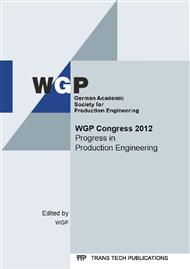[1]
Breckweg, A.: Automatisiertes und prozessüberwachtes Radialclinchen höherfester Blechwerkstoffe. Dissertation. Jost-Jetter, Heimsheim.
Google Scholar
[2]
Neugebauer, R.; Israel, M.: Clinchen von Stahl- und Aluminiumblechen größerer Dicke. EFB-Forschungsbericht (in Druck), Hannover, (2012).
Google Scholar
[3]
dvs Deutscher Verband für Schweißen und verwandte Verfahren e.V.: Clinchen - Überblick. Merkblatt DVS/EFB 3420. DVS-Verlag, Düsseldorf, (2002).
DOI: 10.1002/mawe.19780090512
Google Scholar
[4]
Hahn, O.; Klemens, U.: Technologiespeicher mechanische Fügetechnik - Beispiel Durchsetzfügetechnik. EFB, Hannover, (1995).
Google Scholar
[5]
Hahn, O.; Klemens, U.: Fügen durch Umformen, Nieten und Durchsetzfügen. Innovative Verbindungsverfahren für die Praxis. Verl. und Vertriebsges., Düsseldorf, (1996).
Google Scholar
[6]
Lange, K.: Umformtechnik. Handbuch für Industrie und Wissenschaft. - 4: Sonderverfahren, Prozeßsimulation, Werkzeugtechnik, Produktion. Springer, Berlin, (1993).
DOI: 10.1007/978-3-642-58047-5_13
Google Scholar
[7]
Matthes, K. -J.: Fügetechnik. Überblick - Löten - Kleben - Fügen durch Umformen ; mit 63 Tabellen und 23 Tafeln. Fachbuchverl. Leipzig im Carl-Hanser-Verl., München ;, Wien, (2003).
Google Scholar
[8]
Westkämper, E. et al.: Clinchen höher- und hochfester Bleche mit überlagerter Bewegung. EFB, Hannover, (2009).
Google Scholar
[9]
Lange, K.: Umformtechnik. Handbuch für Industrie und Wissenschaft. Springer, Berlin [etc. ], (1984).
Google Scholar
[10]
Dietrich, S.: Grundlagenuntersuchungen zu neuen matrizenlosen Umformfügeverfahren. Dissertation. Verlag Wissenschaftliche Scripten, Zwickau, (2007).
Google Scholar
[11]
Doege, E.; Behrens, B. -A.: Handbuch Umformtechnik. Grundlagen, Technologien, Maschinen. Springer, Berlin, Heidelberg, New York, (2007).
DOI: 10.1007/978-3-642-04249-2
Google Scholar
[12]
Klein, B.: FEM. Grundlagen und Anwendungen der Finite-Element-Methode im Maschinen- und Fahrzeugbau. Vieweg+Teubner Verlag, Wiesbaden, (2010).
DOI: 10.1007/978-3-8348-2134-8
Google Scholar
[13]
Steinke, P.: Finite-Elemente-Methode. Rechnergestützte Einführung. Peter Steinke. Springer, Berlin, Heidelberg, (2010).
DOI: 10.1007/978-3-642-53937-4
Google Scholar
[14]
Varis, J.; Lepistö, J.: A simple testing-based procedure and simulation of the clinching process using finite element analysis for establishing clinching parameters. In Thin-Walled Structures, 2003, 41; S. 691–709.
DOI: 10.1016/s0263-8231(03)00026-0
Google Scholar
[15]
Paula, A. de et al.: Finite element simulations of the clinch joining of metallic sheets. In Journal of Materials Processing Technology, 2007, 182; S. 352–357.
DOI: 10.1016/j.jmatprotec.2006.08.014
Google Scholar
[16]
Lee, C. -J. et al.: Design of mechanical clinching tools for joining of aluminium alloy sheets. In Materials and Design, 2010, 31; S. 1854–1861.
DOI: 10.1016/j.matdes.2009.10.064
Google Scholar
[17]
Mucha, J.: The analysis of lock forming mechanism in the clinching joint. In Materials & Design, 2011, 32; S. 4943–4954.
DOI: 10.1016/j.matdes.2011.05.045
Google Scholar
[18]
Israel, M.: Vergleichende Untersuchungen zur Festigkeit und zum Versagensverhalten umformgefügter Verbindungen unter statischer und zyklischer Belastung. Diplomarbeit, Dresden, (2005).
Google Scholar
[19]
Saberi, S. et al.: Influence of plastic anisotropy on the mechanical behavior of clinched joint of different coated thin steel sheets. In International Journal of Material Forming, 2008, 1; S. 273–276.
DOI: 10.1007/s12289-008-0349-9
Google Scholar
[20]
Coppieters, S. et al.: Determination of the flow stress and contact friction of sheet metal in a multi-layered upsetting test. In Journal of Materials Processing Technology, 2010, 210; S. 1290–1296.
DOI: 10.1016/j.jmatprotec.2010.03.017
Google Scholar
[21]
Oudjene, M. et al.: Shape optimization of clinching tools using the response surface methodology with Moving Least-Square approximation. In Journal of Materials Processing Technology, 2009, 209; S. 289–296.
DOI: 10.1016/j.jmatprotec.2008.02.030
Google Scholar
[22]
Lange, K.: Umformtechnik. Handbuch für Industrie und Wissenschaft. - 2: Massivumformung. Springer, Berlin, (1988).
DOI: 10.1007/978-3-662-10688-4
Google Scholar
[23]
Fritz, A. H.; Schulze, G.: Fertigungstechnik. Springer-Verlag Berlin Heidelberg, Berlin, Heidelberg, (2008).
Google Scholar
[24]
Israel, M.: Verfahrensgrenzen mechanischer Fügeverfahren für Blechverbindungen großer Dicke. Diplomarbeit, Dresden, (2012).
Google Scholar
[25]
Hahn, O.; Schmid, E.: Numerische Analyse des Clinchprozesses mit dreigeteilter Matrize. Shaker, Aachen, (2004).
Google Scholar
[26]
Hahn, O.; Dölle, N.: Verfahrenssimulation des Durchsetzfügens kaltverfestigter Aluminiumwerkstoffe zur rechnergestützten Werkzeugentwicklung. EFB, Hannover, (2002).
Google Scholar


